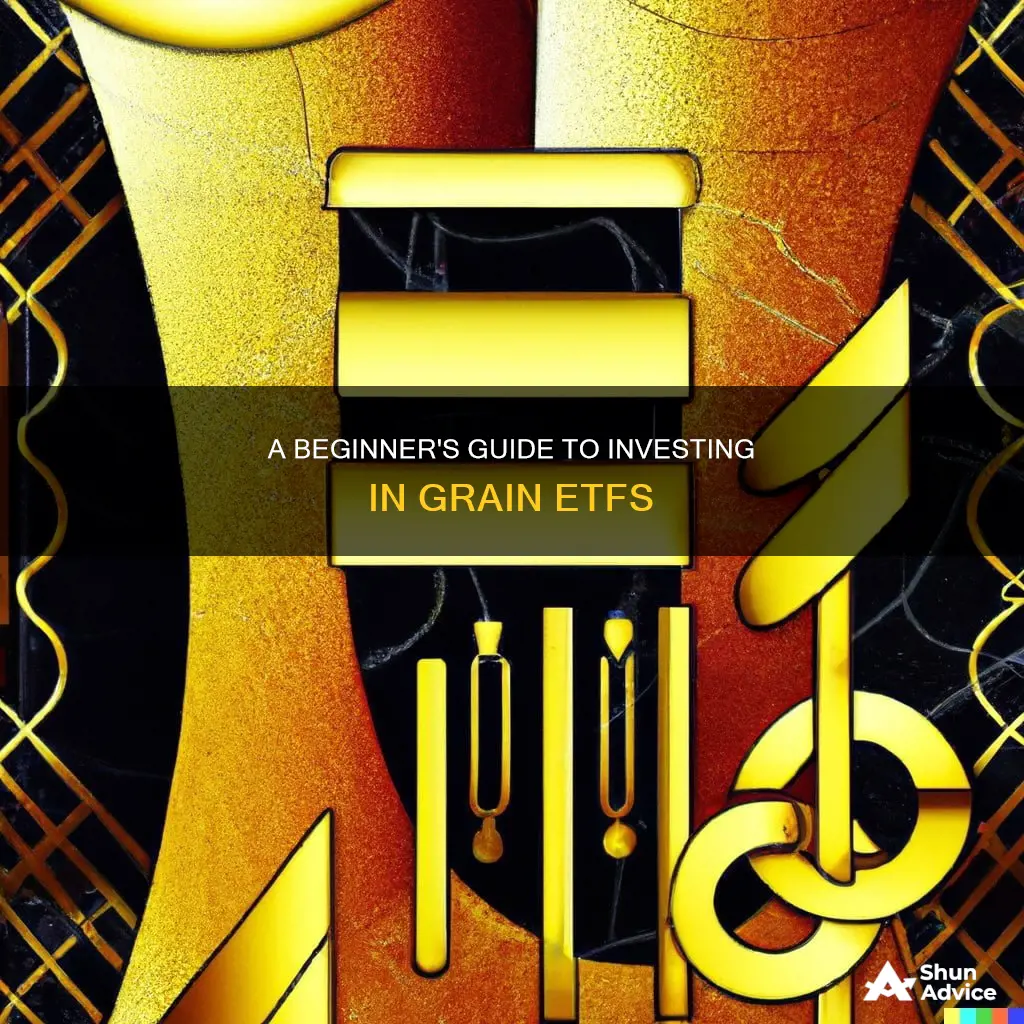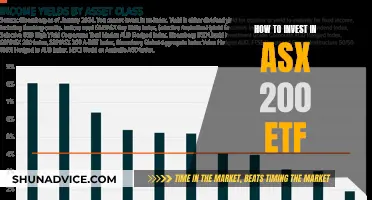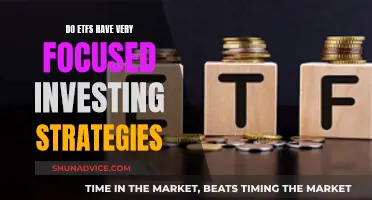
Investing in grain ETFs can be an attractive option for those looking to gain exposure to the commodities market. Wheat, corn, and soybeans are some of the most popular grains for investment, with rising global demand driving up prices. Grain ETFs offer a simplified way to invest in these commodities without the need for a complicated futures exchange account. However, it's important to note that grain markets can be highly volatile, and investing in grain commodity futures is generally recommended only for those with a high-risk tolerance. For those seeking lower-risk options, agricultural ETFs like the Teucrium Wheat Fund (WEAT) provide a way to gain exposure to wheat futures with less risk.
| Characteristics | Values |
|---|---|
| How to invest in grains | Trade in grain commodities such as corn, soybeans, and wheat, which are enjoying significant price increases due to rising worldwide demand. |
| How it works | Investors can gain exposure to the grain market by trading agricultural commodity futures, options, and exchange-traded funds (ETFs) based on individual risk tolerance and financial strength. |
| Risk factors | Grain futures are highly leveraged and volatile; options carry lower risk but can still result in losses; agricultural ETFs carry the least amount of risk. |
| Examples of grain ETFs | Teucrium Wheat Fund (WEAT), Teucrium Soybean Fund (SOYB), Teucrium Corn Fund (CORN), PowerShares DB Agriculture ETF |
What You'll Learn

Understanding the risks of investing in grain ETFs
While investing in grain ETFs can be a great way to gain exposure to the grain market, there are several risks that investors should be aware of before diving in. Here are some key risks to consider when investing in grain ETFs:
Market Risk
Market risk is the possibility of losing money due to factors that impact the overall performance of the grain market. Grain prices can be highly volatile, influenced by various factors such as weather conditions, crop yields, demand fluctuations, and global economic conditions. This volatility can lead to significant price swings, potentially affecting the value of your investment. It is important to monitor market conditions and stay informed about factors that may impact grain prices.
Liquidity Risk
Liquidity risk refers to the potential difficulty in buying or selling an ETF without significantly impacting its price. Grain ETFs may have lower trading volumes and less active markets compared to other types of ETFs, which can make it challenging to enter or exit a position at your desired price. Ensure you review the trading volume, bid-ask spreads, and underlying asset liquidity of the specific grain ETF you are considering.
Tax Risk
Tax risk can vary for different types of ETFs, and it's important to understand how your investment may be taxed. For example, international grain ETFs or those that use derivatives may have different tax treatments. Consult with a tax advisor to understand the potential tax consequences before investing in grain ETFs.
Tracking Error Risk
Tracking error risk is relevant for index-based grain ETFs. It refers to the possibility that the performance of the ETF may deviate from the index it is tied to. This can be influenced by factors such as the skill of the portfolio manager, taxes, capital gains distributions, and the degree to which the ETF replicates the index. Review the historical tracking error of the grain ETF to assess how closely it has tracked its target index over time.
Concentration Risk
Concentration risk arises when a grain ETF is heavily weighted towards specific grains or sectors within the agriculture industry. For example, a grain ETF may have a significant portion of its holdings in wheat, soybeans, or corn. While diversification within the agriculture sector can provide a more balanced exposure, concentration in certain grains can increase the impact of price movements in those specific commodities on the overall performance of the ETF.
Regulatory Risk
Grain ETFs may also face regulatory risks, particularly in certain regions. For example, within the European Union, regulations defined by the UCITS directive restrict the launch of ETFs that focus on a single commodity, such as wheat. Ensure you understand the regulatory landscape for grain ETFs in your desired investment locations.
A Beginner's Guide to Investing in ETFs with Fidelity
You may want to see also

How to invest in grain commodity futures
Grain commodity futures are financial contracts that allow investors to buy or sell specific amounts of grains, such as wheat, corn, or soybeans, at a predetermined price on a future date. These contracts are standardised, traded on exchanges, and involve parties with opposing views on the future price direction of the underlying grain commodity.
Step 1: Understand the Risks and Mechanics of Futures Contracts
Before investing in grain commodity futures, it is crucial to recognise that they are highly risky and volatile. A futures contract is a legally binding agreement, and investors must closely monitor their trades. The contract details include the quantity of the commodity, initial and maintenance margins, and the delivery date. For instance, a soybean futures contract controls 5,000 bushels of soybeans, with an initial margin of $3,375 and a maintenance margin of $2,500.
Step 2: Open a Brokerage Account
To start trading in grain commodity futures, you will need to open a brokerage account with a firm that offers futures trading. Ensure you select a reputable broker that provides the necessary resources and tools for trading futures.
Step 3: Conduct In-Depth Market Research
Successful futures trading requires a strong understanding of the underlying grain market. Study historical price patterns, supply and demand dynamics, and keep yourself informed about factors that influence grain prices, such as weather conditions, government policies, and global economic trends. The U.S. Department of Agriculture (USDA) website is a valuable source for crop yield estimates and market projections.
Step 4: Develop a Trading Strategy
Formulate a well-defined trading strategy that aligns with your risk tolerance and financial goals. Decide whether you want to take a long or short position, set clear entry and exit points, and implement risk management techniques, such as stop-loss orders, to limit potential losses.
Step 5: Start Trading and Monitor Your Positions
Once you have established a trading strategy, you can begin executing trades through your brokerage account. It is crucial to actively monitor your positions and stay informed about market developments that could impact grain prices. Remember that grain futures are highly leveraged, and even small price movements can result in significant profits or losses.
Step 6: Understand the Role of Commodity Futures Options
Consider exploring commodity futures options, which provide the right, but not the obligation, to buy or sell a futures contract at a specific price before the option expires. Options offer more flexibility and lower risk compared to futures contracts, as your potential loss is limited to the price of the option plus any commissions.
Step 7: Explore Alternative Grain Investment Options
If you are hesitant about the high risk associated with grain commodity futures, consider investing in agricultural exchange-traded funds (ETFs). ETFs, such as those offered by Teucrium, provide exposure to a basket of grain commodities with lower volatility and diversification benefits.
Remember, investing in grain commodity futures carries significant risks, and it is essential to only trade with capital you can afford to lose.
ETF Creators: Smart Investment Strategies for Beginners
You may want to see also

How to buy agricultural ETFs
Agricultural exchange-traded funds (ETFs) are a great way to gain exposure to the agricultural sector and its potential for long-term growth. They are a convenient, diversified investment option that tracks the performance of agricultural commodities, companies, and indexes. Here is a step-by-step guide on how to buy agricultural ETFs:
- Understand the Types of Agricultural ETFs: There are two main types of agricultural ETFs: agribusiness ETFs and agricultural commodity ETFs. Agribusiness ETFs invest in the stocks of companies involved in the agriculture supply chain, such as seed and fertilizer manufacturers, farm machinery producers, and food processing companies. Agricultural commodity ETFs, on the other hand, invest directly or indirectly in agricultural commodities like grains, dairy, and livestock.
- Evaluate Your Investment Goals and Risk Tolerance: Before investing, consider your financial goals and risk tolerance. Agricultural commodity ETFs tend to be more volatile due to their direct exposure to commodity price fluctuations. They offer the potential for high returns but come with higher risks. Agribusiness ETFs, on the other hand, offer more stability as they invest in diversified portfolios of established companies.
- Research and Compare Different Agricultural ETFs: Look for ETFs with strong performance histories and low expense ratios. Evaluate their underlying assets, liquidity, and global diversification. Consider factors such as the ETF's focus on specific commodities or companies, their supply chain positioning, dividend potential, and environmental, social, and governance (ESG) criteria.
- Choose a Brokerage Platform: Select a reputable brokerage platform that offers a range of agricultural ETFs. Compare the fees, features, and tools provided by different platforms to make an informed decision.
- Open an Account and Deposit Funds: Sign up for an account with your chosen brokerage platform and link your bank account. Deposit funds into your brokerage account to start investing.
- Purchase Agricultural ETFs: Once your account is funded, you can buy the agricultural ETFs of your choice. Carefully review the ETF's prospectus and consider seeking advice from a financial advisor to ensure the investment aligns with your financial goals and risk tolerance.
- Monitor and Rebalance Your Portfolio: Regularly review the performance of your agricultural ETFs and make adjustments as needed. Periodic rebalancing is recommended to maintain your target allocations over time. Remember that investing in commodities and stocks carries risks, and the value of your investments can go up or down.
By following these steps, you can invest in agricultural ETFs and gain exposure to the agriculture sector. Remember to do your own research, understand the risks involved, and consult with a financial professional before making any investment decisions.
ETFs: Understanding Their Status Under the 1940 Act
You may want to see also

The best wheat ETFs/ETCs
Wheat ETFs provide investors with exposure to wheat futures, without the need for a complicated futures exchange account. However, there are no wheat ETFs that are domiciled within the European Union. This is due to the regulatory framework defined by the UCITS directive, which requires that an index (and thus also corresponding ETFs) must always provide a minimum degree of diversification and may not consist of only one component.
If you want to invest in a single commodity like wheat, you can do so via Exchange-Traded Commodities (ETCs). ETCs track the value of wheat based on futures contracts and are backed with collateral, which is usually checked on a daily basis. Wheat ETCs are a suitable instrument for participating in the price development of wheat, but it is important to remember that you are investing in futures contracts and not directly in wheat.
Some of the best wheat ETCs include:
- WisdomTree WheatJE00BN7KB664
- WisdomTree Wheat - EUR Daily HedgedJE00B78NNK09
- The Teucrium Wheat Fund (WEAT)
Farmland ETF: A Smart Investment Strategy
You may want to see also

How to invest in wheat using ETFs/ETCs
Wheat ETFs provide investors with exposure to wheat futures, without the need for a complicated futures exchange account. There are no wheat ETFs that are domiciled within the European Union. This is due to the regulatory framework defined by the UCITS directive, which requires indices to always provide a minimum degree of diversification. If you want to invest in wheat in the EU, you can do so via Exchange-Traded Commodities (ETCs). ETCs track the value of wheat based on futures contracts and are backed by collateral, which is usually cash investments or securities with top credit standing.
When choosing a wheat ETF or ETC, consider the following factors in addition to the methodology of the underlying index and performance of an ETF: size, cost, age, income, domicile, and replication method.
- WisdomTree WheatJE00BN7KB664
- WisdomTree Wheat - EUR Daily HedgedJE00B78NNK09
- Teucrium Wheat Fund (WEAT)
Agricultural ETFs carry the least amount of risk for the grain investor. The PowerShares DB Agriculture ETF tracks an agricultural index that includes wheat, corn, soybeans, and sugar. Teucrium Funds offers the Teucrium Corn ETF and the Teucrium Soybean ETF for investors who want a pure play on the underlying commodity. The potential loss is limited to the ETF purchase price plus any fees or commissions.
Currency ETF Investment: A Guide to Getting Started
You may want to see also
Frequently asked questions
Investing in grain ETFs provides exposure to the price of wheat, corn, soybeans and other grains without the need for a complicated futures exchange account. This allows investors to benefit from rising prices of these commodities without having to directly trade them.
Examples of grain ETFs include the Teucrium Wheat Fund (WEAT), Teucrium Corn Fund (CORN) and Teucrium Soybean Fund (SOYB).
Before investing in grain ETFs, it is important to assess your individual risk tolerance and financial strength. Grain markets are highly volatile, and futures investors must constantly monitor their trades. It is also worth noting that there are no grain ETFs domiciled within the European Union due to regulatory restrictions.







